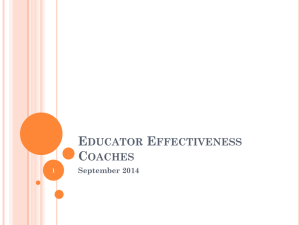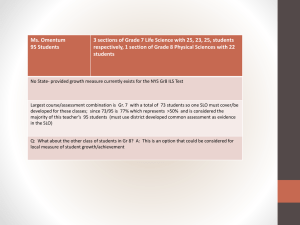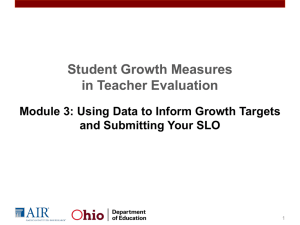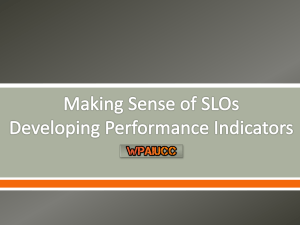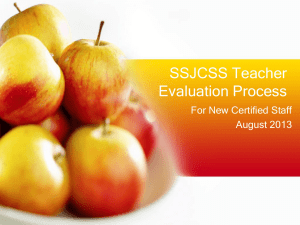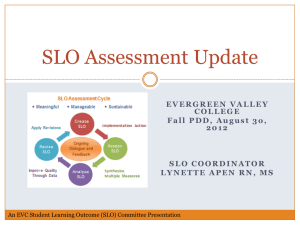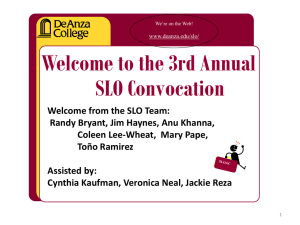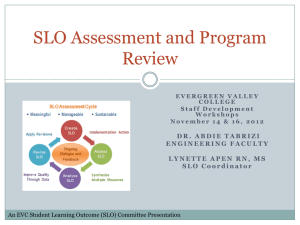SLOs for SPED and SSPs - Department of Assessment, Research
advertisement
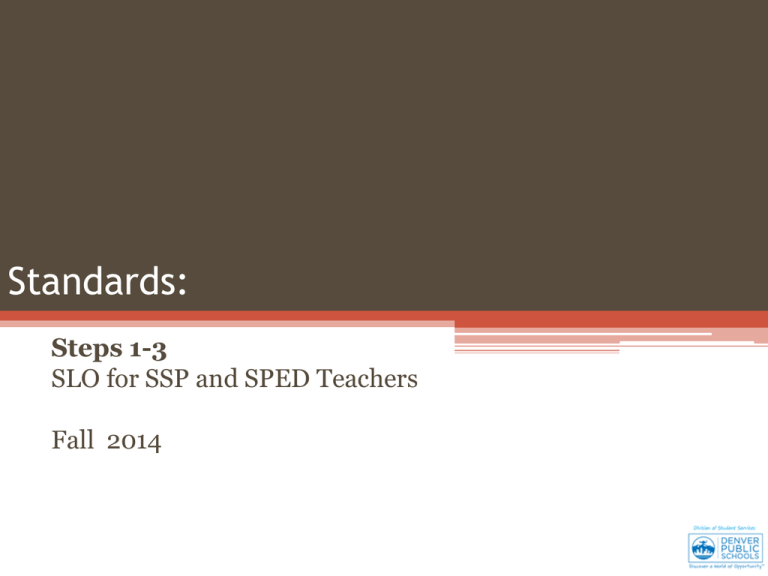
Standards: Steps 1-3 SLO for SSP and SPED Teachers Fall 2014 SLO Agenda Introductions Setting Norms General Guidance Review Objective Statement Performance Criteria Baseline Welcome! Name School or Worksite Name A Unique Fact about You SLO Agenda Introductions Setting Norms General Guidance Review Objective Statement Performance Criteria Baseline Setting Norms • Norm One • Norm Two • Norm Three What does this look like to you? SLO: Step 1-3 Overview/Objectives Goal One: Participants will receive general guidance for development of an SLO Goal Two: Participants will review the Objective statement Goal Three: Participants will know where to find the performance criteria from the standards or develop performance criteria if the standard doesn’t have details Goal Four: Participants will understand how to determine baseline of functioning for the SLO SLO Agenda Introductions Setting Norms General Guidance Review Objective Statement Performance Criteria Baseline General Guidance Objective Participants will receive general guidance for development of an SLO What standards should I use for my objective statement? The Colorado State Academic and Health Standards Which include the Common Core State Standards http://www.cde.state.co.us/standardsandinstruction/coloradostandards Page 23-24 in Procedural Manual: The Colorado State Recommended IEP The Standards Colorado Academic and Health Standards Academic Standards Math Literacy CCSS Social Studies Health Standards CCSS EEO EEO Arts EEO Physical and Personal PE Movement Competence and Understanding Science EEO World Languages Wellness Prevention Risk Management Wellness Emotional and Social How do I choose standards? “What are the common needs of all of your students?” Some SSP groups might ask… “What are the common needs of a subgroup of your students?” SPED Teachers Automatically have a Common Need! SPED General AN MIA/PLEX DHH MI/MIS Literacy skills are typically a need that all student on your case load have Social Emotional Wellness and Academic Needs Social Skills Communication RepetitiveRestrictive Behaviors Listening Speaking Language Adaptive Functioning (communication is a common adaptive function need) Use the CO Academic : Literacy Standards Use the CO Academic: Literacy Standards AND Use the CO Comprehensive Health Standards : Social Emotional Wellness and Risk Taking Strand Use the CO Academic: Literacy Standardslistening and speaking strands AND Use the Co Comprehensive Health Standards: Social Skills and Risk Taking Strand Use the CO Academic: Literacy Standardslistening and speaking strands Use the CO Academic: Literacy Standardslistening and speaking strands Certain SSP Groups Automatically have a Common Need! See your department supervisors for additional guidance SLP OT/PT Psy/SW Nursing DHH Audiology Vision Communication Articulation Language Motor Skills Social Emotional Communication Health Listening Language Speech Communication Navigation Use the CO Academic : Literacy Standards AND/OR Use the CO Comprehensive Health Standards: Social Emotional Wellness (pragmatics, social skills etc.) Use the CO Comprehensive Health Standards : Movement Strand AND CO Academic: Literacy Standards Use the CO Comprehensive Health Standards : Social Emotional Wellness and Risk Taking Strand and Academic Standards: Literacy AND/OR Department Goals Use the CO Comprehensive Health Standards AND/OR Department Goals Use the CO Academic : Literacy Standards AND Expanded Core Standards for DHH/Professio nal standards for Audiology Use the CO Academic : Literacy Standards AND Expanded Core Standards for Vision I have students at many grade levels. How do I choose the grade level standard? Start with the oldest grade level on your case load. Look at the standard for this grade level. Find the strand of this standards for each subsequent grade level. Third Grade Second Grade First Grade I am concerned about the statement, “All students will…” My student’s needs are too diverse. This is why they are on an IEP. All teachers and ssps are faced with this same dilemma. Think of the objective statement as a year long content language objective that reflects your overall goal for your case load. You will be able to differentiate with your • Performance criteria • Baselines and Trajectories • Evaluation Rubric Can I still teach basic skills like math facts and spelling under a broad problem solving or comprehension goal?* Problem Solving Number Sense, Fact Fluency and Procedure Written Composition Handwriting, Spelling and Grammar Reading Comprehension Phonological Awareness, Phonics, Fluency *This is most applicable to schools that might ask you to write your SLO based on an Essential Learning Goal. Isn’t an SLO the same as an IEP goal? IEP Goal • Based on individual students needs • Developed by the IEP team • Is an annual goal (e.g. December to December) that multiple teams might address over two school years • May have multiple team members working on this goal SLO • Based on a need that your collective case load has (or at least a majority of your case load) • Developed by an individual teacher or SSP • Is an objective for the school year (e.g. Aug to May) • Is typically going to be worked on by the individual Key Points: General Guidance SLOs can be differentiated with the performance criteria, baselines and trajectories and in the evaluation rubric General Guidance The intent of the SLO is to address a common expectation you have for your entire case load or if necessary a sub group of your case load General Guidance General Guidance • Summary IEP Goals and SLOs might appear to be similar but fundamentally they are different while more and likely addressing the same needs SLO Agenda Introductions Setting Norms General Guidance Review Objective Statement Performance Criteria Baseline State of the State Objectives Participants will review the Objective statement Objective Statement: What will students know and be able to do at the end of the course (services)? Step 1: Creating an Objective Statement Guidelines: • Written in the form, “All students will be able to…” ▫ Should include at least one language domain (reading, writing, listening and speaking) ▫ Should include at least one language function (describing, making request, giving instructions, etc.) ▫ Comprised of standard(s) and/or grade level expectation(s) Step 1: Creating an Objective Statement Guidelines, continued: • Reflect the knowledge and/or skills in both content and language that are critical for students’ success in the current course and future courses (including other content areas). • Cover standard(s) and/or grade level expectation(s) that span the duration of the course, i.e., are covered in multiple units throughout the course Objective Statements All students will be able to orally and in writing, analyze the interrelationship of physical, mental, emotional, and social health for self and others. (Based on 12th grade social emotional wellness standard) Standards Language Domain: Orally and Writing Based: Yes Critical Skill: YES Language Function: analyze Span the Course: YES Guidelines for Objective Statement “All Students will” Standards or grade -Language domain level expectation -Language function Critical skill for success Span the duration of the course Objective Statements All students will be able to orally and in writing, determine or clarify the meaning of unknown and multiple-meaning words by choosing flexibly from a range of strategies (based on 8th grade reading standard) Standards Language Domain: Orally and Writing Based: Yes Language Function: determine and clarify Critical Skill: YES Span the Course: YES Guidelines for Objective Statement “All Students will” Standards or grade -Language domain level expectation -Language function Critical skill for success Span the duration of the course Student Impact Objectives • Objective Statement : All Students will receive strong suicide prevention supports and students needing interventions and assessments will receive strong culturally appropriate suicide intervention and assessments. • Objective Statement: All students receiving a special education evaluation for possible Serious Emotional Disability will receive a culturally responsive appropriate cognitive and socialemotional assessment Speech Language Objective Statements- articulation All students will effectively and clearly present information, findings and supporting evidence in formal and informal setting using appropriate method such as articulation/enunciation (12th grade Oral Expression and Listening standard). Survey back to the standards for your oldest grade level student Guidelines for Objective Statement “All Students will” Standards or grade -Language domain level expectation -Language function Critical skill for success Span the duration of the course Speech Language Objective Statements- language All students will effectively and clearly use verbal and non-verbal language to impact their intent of communication such as syntax, semantics or pragmatics, combination, etc.)(11th grade Oral Expression and Listening standard). Guidelines for Objective Statement “All Students will” Standards or grade -Language domain level expectation -Language function Critical skill for success Span the duration of the course Communication SLO – MI,MIA,DHH, SPED, AN, ECE, etc. All students will effectively and clearly use verbal and non-verbal language to impact their intent of communication (11th grade Oral Expression and Listening standard). Survey back to the standards for your oldest grade level student Guidelines for Objective Statement “All Students will” Standards or grade -Language domain level expectation -Language function Critical skill for success Span the duration of the course Social Emotional Wellness SLO – MIA, AN, Psy, SW All students will orally and in writing, advocate to improve or maintain positive mental and emotional health for self and others (12th grade social emotional wellness standards). Survey back to the standards for your oldest grade level student Guidelines for Objective Statement “All Students will” Standards or grade -Language domain level expectation -Language function Critical skill for success Span the duration of the course Motor SLO – MIS, OT/PT All students will orally explain and demonstrate the application of rules, principals, problem-solving skills, and concepts to traditional and non-traditional movement settings (12th grade social emotional wellness standards). Survey back to the standards for your oldest grade level student Guidelines for Objective Statement “All Students will” Standards or grade -Language domain level expectation -Language function Critical skill for success Span the duration of the course You do… Using the SLO Planning Sheet 1) Identify your standards for the highest grade level, and one grade level above and below 2) Skip the changes from the years… 3) Write your objective name 4) Write your objective statement 5) Write your objective Rational 6) Share in small/large group Key Points: Objective Statement The statement is essentially a year long content language objective Objective Statement The objective statement is directly tied to a standard and often times can have the standards language written into the statement Objective Statement Objective Statement • Summary Some SSP groups might write an SLO that is more of an indirect student impact and usually based on department goals SLO Agenda Introductions Setting Norms General Guidance Review Objective Statement Performance Criteria Baseline Performance Criteria and Rubric Objectives Participants will know where to find the performance criteria from the standards or develop performance criteria if the standard doesn’t have details Performance Criteria & Rubric Guidelines: • Each SLO must include at least 3 criteria that adequately describe the content, rigor and language in the Objective Statement Each criterion should describe what a proficient student will be able to do at the end of the course • Each criterion should clearly describe a distinct skill or task and be measurable/observable • • There should be a correlating rubric that defines the various levels of development students move through as they progress toward the Objective. • The “proficiency” level on the rubric should use the same language as the criterion itself. Where can I find the performance written in the details of the criteria? Most of the time, it isstandard. Objective Statement 5th Grade Literacy All students will use key ideas and details to understand and interpret literacy text they have read • Quote accurately from a text • Draw inference from a text • Determine theme from details • Compare and contrast two ore more characters point of view Where can I find the performance One more example criteria? Objective Statement High School Social Emotional Wellness All students will orally and in writing analyze the interrelationship of physical, mental, emotional and social health. • Analyze characteristic of a healthy individual • Describe how mental and emotional health affect behaviors • Evaluate effective strategies for stress • Analyze symptoms of depression Objective Statement 5th Grade Literacy All students will use key ideas and details to understand and interpret literacy text they have read Performance Criteria • Quote accurately from a text • Draw inference from a text • Determine theme from details • Compare and contrast two ore more characters point of view Objective Statement High School Social Emotional Wellness All students will orally and in writing analyze the interrelationship of physical, mental, emotional and social health. Performance Criteria Analyze characteristic of a healthy individual • Describe how mental and emotional health affect behaviors • Evaluate effective strategies for stress • Analyze symptoms of depression • Guidelines for Performance Criteria describe what a proficient student will be able to do describe a distinct skill or task and be measurable/observable Essence of Performance Criteria “What is the evidence to prove your students have met the standard?” Rubrics to measure the performance criteria 4 Point Rubric (expanded) Individual Student Matrix Traditional Rubric ▫ Not meeting ▫ Partially met ▫ Met ▫ Exceeded ▫ Can be expanded for multiple grades Who: ▫ Sped Teachers ▫ PSY/SW ▫ Nursing • Individual Trajectories ▫ Each student on a separate line ▫ Set individual targets ▫ Check off as skills are mastered Who: ▫ Teachers who serve 3 -21 yo ▫ SLP ▫ OT/PT 4 point rubric (expanded) Not Yet Approaches Meets (put your performance criteria here) Advanced 4 point rubric (expanded) Not Yet Approach es Meets (1st graders) Meets (2nd graders) Meets (3rd graders) Advanced Example Rubric All students will use a plan, draft, and write a variety of informational text (3rd grade standard) Not Yet Approaches Meets (1st grade) Meets (2nd grade Meets (3rd grade) -writes explanation -Names topics -Supplies some facts -Provides a sense of closure -Writes “how to’s” -Organized text using main idea -Organized ideas using pictures, graphic organizers -States a focus for their writing -Introduces topic -States main idea -Includes sufficient details or facts -Develops a topic with facts -Provides Conclusion Advanced Example Student Matrix List of skills to be mastered S T U D E N T S Progress through the skills Being developed for SLP, OT/PT and Hearing and Vision Itinerant Teachers Appropriate when you are serving 3 to 21 year old students on your caseload You do… Using the SLO Planning Sheet 1) Identify your performance criteria 2) Create a rubric 3) For SLP, OT/PT, and Itinerant Teachers refer to your department supervisor for the individual students matrix 4) Share in small/large group Key Points: Performance Criteria Rubrics allow for the evaluation of each students mastery and the meeting on the rubric is the performance criteria Performance Criteria This is how the students demonstrate their mastery of the learning objective Performance Criteria Performance Criteria • Summary Can be expanded out for various grade level expectations and turned into a matrix for mastery of skills SLO Agenda Introductions Setting Norms General Guidance Review Objective Statement Performance Criteria Baseline Baseline Objectives Participants will understand how to determine baseline of functioning for the SLO Assessment – Any opportunity that provides information on student learning Assessment Portfolios Standardized tests Quizzes School-created tests Teacher-created tests Rubric-based observations Homework assignments Projects Exit tickets Performances Drawings/Sketches Performance in a content-based game Conversations with students Guiding Principles of Assessment Reliability Consistency Students with the same ability get the same score. Validity Good information of student learning Alignment Assessment measures what we intend it to measure. We make good decisions about teaching our students. Body of Evidence A combination of data sources that provides the best possible estimate of a student’s knowledge and skills. Why one assessment score isn’t enough - 1. Data is not fact and no assessment is a perfect measure 2. Single assessments provide only a snapshot of one time on one day 3. Assessments do not measure everything; they sample what students know Key Ideas about Assessment • Assessing thoughtfully means: ✓ Teach students how to accomplish the rigor of our standards before we hold them accountable for having mastered that rigor (and grading accordingly) ✓ requiring of ourselves that assessments we intend to use have sufficient connection to instructional plans ✓ searching out what students’ work tells us about their learning needs, and planning and adjusting further instruction accordingly ✓ Using assessments when they are instructionally relevant both in content and in timing Importance of Baseline Data By knowing where students are starting at… …you can be more effective at … • planning instruction • supporting students • maximizing student learning potential Baseline data should be • intimately connected to objective statement and performance criteria • provide information specifically on where students are currently at, on the rubrics you have created You do… Using the SLO Planning Sheet 1) Determine your baseline data sources 2) Determine your rational for the data sources 3) Develop a plan for collecting your baseline of data 4) Share out Key Points: Baseline To be valid, make sure your baseline is tied to the objective statements and performance criteria Baseline Your baseline of data comes from multiple sources Baseline Baseline • Summary Be prepared to collect a baseline of data when your return to the classroom
